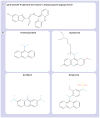New hopes from old drugs: revisiting DNA-binding small molecules as anticancer agents
- PMID: 20001804
- PMCID: PMC2821823
- DOI: 10.2217/fon.09.127
New hopes from old drugs: revisiting DNA-binding small molecules as anticancer agents
Abstract
Most of the anticancer chemotherapeutic drugs that are broadly and successfully used today are DNA-damaging agents. Targeting of DNA has been proven to cause relatively potent and selective destruction of tumor cells. However, the clinical potential of DNA-damaging agents is limited by the adverse side effects and increased risk of secondary cancers that are consequences of the agents' genotoxicity. In this review, we present evidence that those agents capable of targeting DNA without inducing DNA damage would not be limited in these ways, and may be as potent as DNA-damaging agents in the killing of tumor cells. We use as an example literature data and our own research of the well-known antimalarial drug quinacrine, which binds to DNA without inducing DNA damage, yet modulates a number of cellular pathways that impact tumor cell survival.
Figures


Similar articles
-
The modulation of the DNA-damaging effect of polycyclic aromatic agents by xanthines. Part I. Reduction of cytostatic effects of quinacrine mustard by caffeine.Biochem Pharmacol. 2002 Feb 15;63(4):625-34. doi: 10.1016/s0006-2952(01)00904-2. Biochem Pharmacol. 2002. PMID: 11992630
-
DNA-damaging agents in cancer chemotherapy: serendipity and chemical biology.Chem Biol. 2013 May 23;20(5):648-59. doi: 10.1016/j.chembiol.2013.04.007. Chem Biol. 2013. PMID: 23706631 Review.
-
Methods for Elucidation of DNA-Anticancer Drug Interactions and their Applications in the Development of New Drugs.Curr Pharm Des. 2016;22(44):6596-6611. doi: 10.2174/1381612822666160831114622. Curr Pharm Des. 2016. PMID: 27587197 Review.
-
Role of Chromatin Damage and Chromatin Trapping of FACT in Mediating the Anticancer Cytotoxicity of DNA-Binding Small-Molecule Drugs.Cancer Res. 2018 Mar 15;78(6):1431-1443. doi: 10.1158/0008-5472.CAN-17-2690. Epub 2018 Jan 16. Cancer Res. 2018. PMID: 29339544 Free PMC article.
-
The potential of combi-molecules with DNA-damaging function as anticancer agents.Future Med Chem. 2017 Mar;9(4):403-435. doi: 10.4155/fmc-2016-0229. Epub 2017 Mar 6. Future Med Chem. 2017. PMID: 28263086 Review.
Cited by
-
Mechanisms for Kir channel inhibition by quinacrine: acute pore block of Kir2.x channels and interference in PIP2 interaction with Kir2.x and Kir6.2 channels.Pflugers Arch. 2011 Oct;462(4):505-17. doi: 10.1007/s00424-011-0995-5. Epub 2011 Jul 22. Pflugers Arch. 2011. PMID: 21779761
-
Quinacrine causes apoptosis in human cancer cell lines through caspase-mediated pathway and regulation of small-GTPase.J Biosci. 2020;45:43. J Biosci. 2020. PMID: 32098922
-
Acridine and acridinones: old and new structures with antimalarial activity.Open Med Chem J. 2011;5:11-20. doi: 10.2174/1874104501105010011. Epub 2011 Mar 9. Open Med Chem J. 2011. PMID: 21673977 Free PMC article.
-
Synthesis, characterization and DNA interaction studies of new triptycene derivatives.Beilstein J Org Chem. 2014 Jun 5;10:1290-8. doi: 10.3762/bjoc.10.130. eCollection 2014. Beilstein J Org Chem. 2014. PMID: 24991281 Free PMC article.
-
Synthesis of Marine-Inspired Multifaceted DNA Damaging Spirooxindoles Combating NSCLC and Associated Bacterial Infection.ACS Med Chem Lett. 2025 Apr 18;16(5):819-828. doi: 10.1021/acsmedchemlett.5c00014. eCollection 2025 May 8. ACS Med Chem Lett. 2025. PMID: 40365419
References
-
- Watson JD, Crick FHC. A Structure for deoxyribose nucleic acid. Nature. 1953;171:737–738. - PubMed
-
- Boer DR, Canals A, Coll M. DNA-binding drugs caught in action: the latest 3D pictures of drug-DNA complexes. Dalton Trans. 2009;(3):399–414. - PubMed
-
- Pindur U, Jansen M, Lemster T. Advances in DNA-ligands with groove binding, intercalating and/or alkylating activity: chemistry, DNA-binding and biology. Curr Med Chem. 2005;12(24):2805–2847. - PubMed
-
- Strekowski L, Wilson B. Noncovalent interactions with DNA: an overview. Mutat Res. 2007;623(1–2):3–13. - PubMed
-
- Ferguson LR, Denny WA. Genotoxicity of non-covalent interactions: DNA intercalators. Mutat Res. 2007;623(1–2):14–23. - PubMed
Publication types
MeSH terms
Substances
Grants and funding
LinkOut - more resources
Full Text Sources
Other Literature Sources
